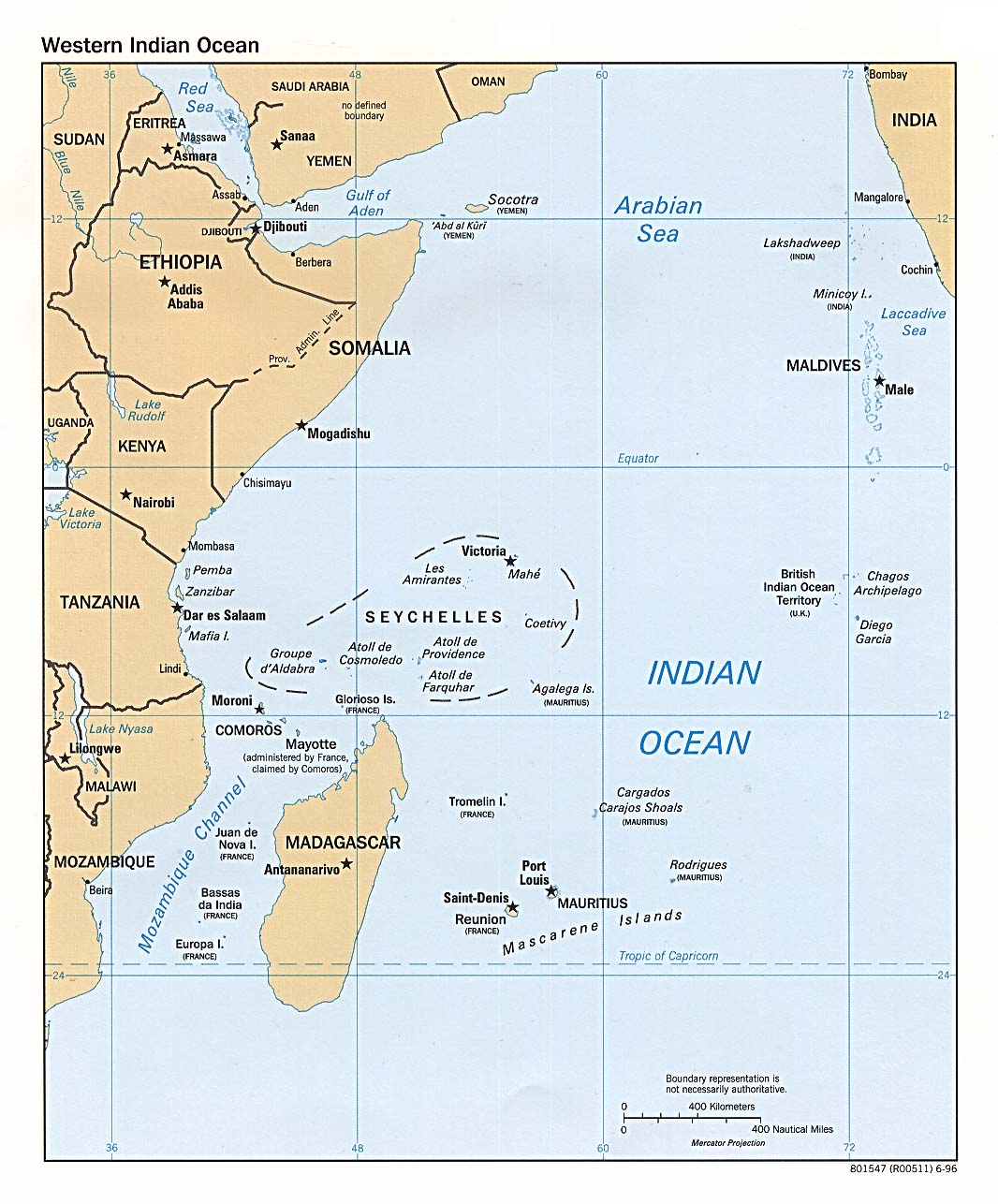
Indian Ocean, the third largest saline-water body of the world, derives its name from India. On the northern side, the ocean is bounded by South Asia, including India. On the west, it is bounded by Africa, while Indochina, the Sunda Islands and Australia corner it from the east. Down south, Indian Ocean is bounded by Antarctica. The Island nations housed by the Indian Ocean are Madagascar (formerly Malagasy Republic), the world's fourth largest island; Comoros, Seychelles, Maldives, Mauritius and Sri Lanka. Indian Ocean covers 20 percent of the water on the Earth's surface. Zambezi, Shatt al-Arab, Indus, Ganges, Brahmaputra, Jubba and Ayeyarwady River are the major rivers flowing into the Indian Ocean. For some more interesting and fun facts about Indian Ocean, go through the following lines.
The Indian Ocean is located between Africa and Austral-Asia.
The waters of the Indian Ocean provides the largest breeding grounds of the world for humpback whales and also a fish which was thought to be extinct was discovered there: the Coelacanth is found in the warm waters off the Comoro islands between Mozambique and Madagascar.
The Northern Indian Ocean also is the most important transport route for oil as it connects the oil-rich countries of the Middle East Each with Asia. Every day tankers are carrying a cargo of 17 million barrels of crude oil from the Persian Gulf on its waters.
Interesting and Fun Facts About Indian Ocean
Indian Ocean is the warmest ocean in the world. However, the warmth of the ocean resists the growth of phytoplankton, except for a few spots here and there, across the water body. Hence, life thriving in the Indian Ocean is limited.
Indian Ocean is known as 'Ratnakara' in the ancient Sanskrit literature. Ratnakara means 'the maker (creator) of jewels'.
The ocean's volume is estimated to be 292,131,000 cubic kilometers. Its average depth is 3,890 meters (12,760 ft).
Its fish are of significant importance to the bordering states, for domestic consumption and export.
The beach sands of Indian Ocean are rich in heavy minerals and the offshore deposits are vigorously exploited by the bordering nations, primarily India, South Africa, Indonesia, Sri Lanka and Thailand.
The important ports and harbors of Indian Ocean include Chennai (Madras; India), Colombo (Sri Lanka), Durban (South Africa), Jakarta (Indonesia), Kolkata (Calcutta; India) Melbourne (Australia), Mumbai (Bombay; India), and Richards Bay (South Africa).
Suez Canal (Egypt), Bab el Mandeb (Djibouti-Yemen), Strait of Hormuz (Iran-Oman), and Strait of Malacca (Indonesia-Malaysia) are the four main access points to the Indian Ocean.
Indian Ocean transports a heavy traffic of petroleum and petroleum products, from the oilfields of the Persian Gulf and Indonesia.
The largest container handling facility in the Indian Ocean has been termed as Port Louis.
The ocean provides major sea routes connecting the Middle East, Africa, and East Asia with Europe and the Americas.
Approximately 40% of the world's offshore oil production comes from the Indian Ocean.
Fishing in Indian Ocean has been restricted to subsistence level.
The lowest point in Indian Ocean is Java Trench, with a depth of 7, 258 m.
The ocean was dominated by the United Kingdom in early 1800s. After the decline of British Empire, Indian Ocean was dominated by India and Australia.
Experts have discovered that a large continent named ‘The Kerguelen Plateau’ has been submerged in the southern part of the Indian Ocean. It is learnt that the submerged continent is of volcanic origin.
Occasional occurrence of icebergs has posed a threat to navigation in the southern regions of the ocean.
Indian Ocean is known as 'Ratnakara' in the ancient Sanskrit literature. Ratnakara means 'the maker (creator) of jewels'.
The ocean's volume is estimated to be 292,131,000 cubic kilometers. Its average depth is 3,890 meters (12,760 ft).
Its fish are of significant importance to the bordering states, for domestic consumption and export.
The beach sands of Indian Ocean are rich in heavy minerals and the offshore deposits are vigorously exploited by the bordering nations, primarily India, South Africa, Indonesia, Sri Lanka and Thailand.
The important ports and harbors of Indian Ocean include Chennai (Madras; India), Colombo (Sri Lanka), Durban (South Africa), Jakarta (Indonesia), Kolkata (Calcutta; India) Melbourne (Australia), Mumbai (Bombay; India), and Richards Bay (South Africa).
Suez Canal (Egypt), Bab el Mandeb (Djibouti-Yemen), Strait of Hormuz (Iran-Oman), and Strait of Malacca (Indonesia-Malaysia) are the four main access points to the Indian Ocean.
Indian Ocean transports a heavy traffic of petroleum and petroleum products, from the oilfields of the Persian Gulf and Indonesia.
The largest container handling facility in the Indian Ocean has been termed as Port Louis.
The ocean provides major sea routes connecting the Middle East, Africa, and East Asia with Europe and the Americas.
Approximately 40% of the world's offshore oil production comes from the Indian Ocean.
Fishing in Indian Ocean has been restricted to subsistence level.
The lowest point in Indian Ocean is Java Trench, with a depth of 7, 258 m.
The ocean was dominated by the United Kingdom in early 1800s. After the decline of British Empire, Indian Ocean was dominated by India and Australia.
Experts have discovered that a large continent named ‘The Kerguelen Plateau’ has been submerged in the southern part of the Indian Ocean. It is learnt that the submerged continent is of volcanic origin.
Occasional occurrence of icebergs has posed a threat to navigation in the southern regions of the ocean.
The Indian Ocean consists of 57 island groups or archipelagos, 16 seas or large gulfs, borders 16 African countries, 18 Asian countries and 1 Australasian state, is home to 40% of the world's offshore oil reserves and covers 5 submerged, oceanic ridges, 5 divergent tectonic plate boundaries and 1 Triple Point.
Because of it's continually warm temperatures, the Indian Ocean also has the highest evaporation level, the lowest resistance to phytoplankton growth and draws the least atmospheric oxygen of all the world's seas, leading to it harbouring the lowest levels of marine life of all the world's oceans.

The Indian Ocean's sea bed is around 12,760 feet deep, but the ocean also consists of two deep trenches which drop to over 25,000 feet deep - the 8,500,000 feet long Java Trench and the Diamantina Trench.
For more information Visit:

0 comments:
Post a Comment